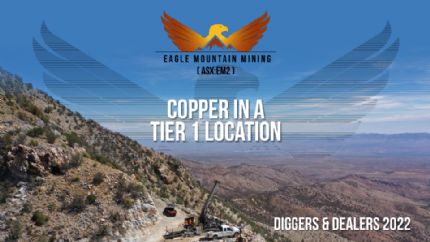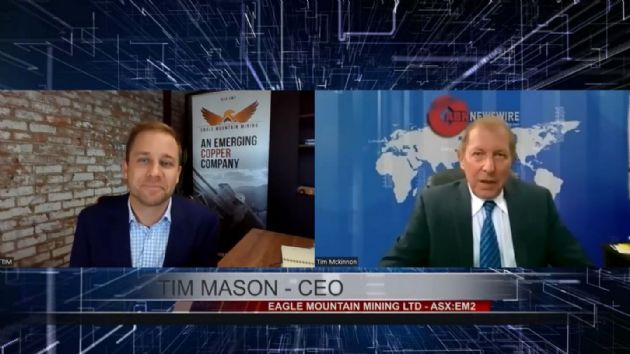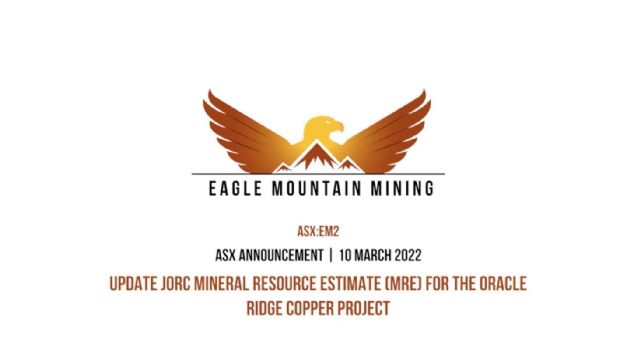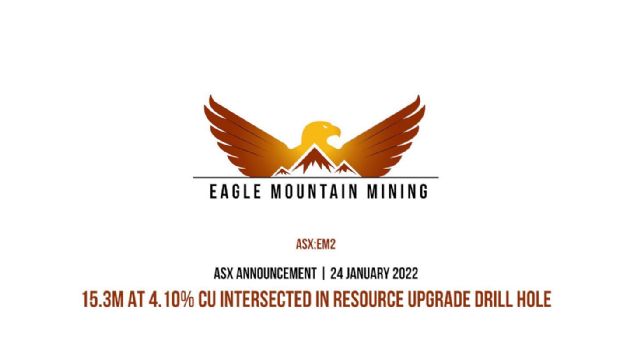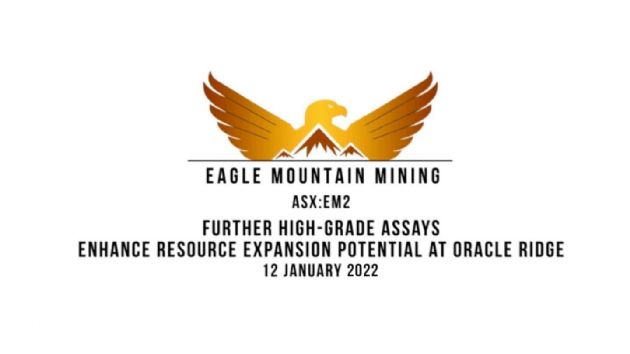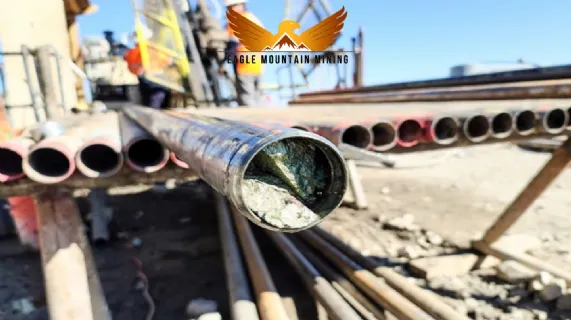
500m Mineralisation Strike Potential at Western Talon
Perth, Sep 29, 2021 AEST (ABN Newswire) - Eagle Mountain Mining Limited ( ASX:EM2) (
ASX:EM2) ( EGMMF:OTCMKTS) is pleased to provide an exploration update at its 100% owned Oracle Ridge Mine Project in Arizona, USA.
EGMMF:OTCMKTS) is pleased to provide an exploration update at its 100% owned Oracle Ridge Mine Project in Arizona, USA.
500m Mineralisation Strike Potential at Western Talon Between 91.5m at 1.37% Cu in hole WT-21-31 and 28.9m at 2.34% Cu in hole WT-21-32.
- Very thick mineralised interval in WT-21-31, including five high-grade zones:
o 91.5m fully diluted at 1.37% Cu, 10.86g/t Ag and 0.38g/t Au, including
- 9.7m at 3.39% Cu, 29.65g/t Ag and 0.67g/t Au, and
- 11.7m at 1.90% Cu, 15.22g/t Ag and 0.52 g/t Au, and
- 14.8m at 1.62% Cu, 11.93g/t Ag and 0.53g/t Au, and
- 8.7m at 2.00% Cu, 15.20g/t Ag and 0.4g/t Au, and
- 8m at 1.9% Cu, 13.92g/t Ag and 0.85g/t Au
- Exceptional high-grade intersections in drill hole WT-21-32 (previously reported as visual observation):
o 28.9m at 2.34% Cu, 21.95g/t Ag and 0.37g/t Au, including
- 0 13.2m at 3.53% Cu, 33.89g/t Ag and 0.54g/t Au. with
- 1.4m at 9.99% Cu, 147g/t Ag, 2.83g/t Au
- WT-21-31 and WT-21-32 occur at the southern and northern end respectively of a 500 metre long corridor with highly prospective geology and limited previous drilling
- Hole WT-21-29 drilled to the east of WT-21-32 shows thinner mineralised zones than surrounding holes
- The new geological model for the Western Talon has two drill rigs testing this strong mineralisation trend
- Assays pending for 16 holes
- Capital raise - firm commitments for $16 million supports ongoing drilling with three diamond rigs
Eagle Mountain Mining CEO, Tim Mason, commented:
"What a week for the Western Talon! WT-21-32 has delivered the best assayed intersection of our resource expansion program so far. While we were assessing the significance of these strong results, hole WT-21-31 presented a very thick mineralised interval in the southernmost hole we have drilled at Oracle Ridge. The five high-grade zones within this intercept are individually significant in their own right; the fact that they occur in the same hole make for yet a further exciting result. The results from drill holes WT-21-32 and WT-21-31 justify our belief in the exploration potential of The Talon zone.
Recent drilling has provided great insight into the geology of The Talon and suggests a potential strike length of over 500 metres. Mineralisation outside of this strike extent remains open within the magnetic geophysical anomaly which defines The Talon. We are eagerly continuing to drill this area as we are now driven by a new geological model. We are also planning additional drill pads and access roads to reach further to the south and southeast tip of The Talon.
Twelve months ago, we had just commenced drilling at Oracle Ridge with one rig on a 20 days on, 10 days off roster and a small team. Today we have three rigs drilling full time, a large and motivated team and some outstanding results to celebrate with our shareholders following our first year of drilling at Oracle Ridge.
We have recently raised $16 million via a strongly supported share placement to institutional and high net worth investors. This placement included $1 million from the Managing Director, Charles Bass which will settle subject to shareholder approval.
Assays have been received for three drill holes at The Talon Zone, namely WT-21-29 and the high-grade zones from drill hole WT-21-31 and WT-21-32. These results are summarised in Table 1*. Figure 1* illustrates the location of these new results.
WT-21-31
An very thick mineralised zone was intersected in WT-21-31 from 253.5 metres to 345 metres for a total downhole length of 91.5 metres. This interval contains five high-grade zones (Figure 2*) varying in thickness between approximately 5 and 15 metres and displays strong magnetite and copper sulphides. These high-grade intercepts are separated by weakly to moderately altered and mineralised sediments. Results include:
- 91.5m at 1.37% Cu, 10.86g/t Ag and 0.38g/t Au, including
o 9.7m at 3.39% Cu, 29.65g/t Ag and 0.67g/t Au, and
o 11.7m at 1.90% Cu, 15.22g/t Ag and 0.52 g/t Au, and
o 14.8m at 1.62% Cu, 11.93g/t Ag and 0.53g/t Au, and
o 8.7m at 2.00% Cu, 15.20g/t Ag and 0.4g/t Au, and
o 8.0m at 1.90% Cu, 13.92g/t Ag and 0.85g/t Au
The 91.5 metre zone is significantly thicker than any mineralisation encountered in nearby holes. The only area of the mine where similar thicknesses and grade are found is to the north where recent reported results include 110.1m at 1.06% Cu, 9.64g/t Ag and 0.16g/t Au (WT-21-24) and 96.1m at 0.98% Cu, 7.84g/t Ag and 0.15g/t Au (WT-21-18; see ASX announcement 15 September 2021). The results from WT-21-31 are highly encouraging and indicate that substantial thicknesses of mineralisation could occur also in The Talon area.
Further assays for the upper part and the lower part of WT-21-31 (above and below the high-grade zone) remain outstanding.
WT-21-32
WT-21-32 was drilled in the Western Talon (Figure 1*, Figure 5*, Figure 6*) area and encountered a 28.9 metre zone of moderate to strong copper mineralisation (see ASX announcement 23 September 2021). Assays have now been received for this interval, confirming its very high-grade nature. The best results include:
- 28.9m at 2.34% Cu, 21.95g/t Ag, 0.37g/t Au from 270.6m, across two zones:
- Upper zone:
o 13.2m at 3.53% Cu, 33.89g/t Ag, 0.54g/t Au from 270.6m, including
o 5.4m at 4.85% Cu, 54.80g/t Ag, 0.96g/t Au from 271.4m, including
o 1.4m at 9.99% Cu, 147g/t Ag, 2.83g/t Au from 271.4m
- Lower zone:
o 7.2m at 2.04% Cu, 15.71g/t Ag, 0.29 g/t Au from 292.3m
These results are some of the best ever at Oracle Ridge. The upper zone is characterised by abundant disseminated to semi-massive bornite and chalcopyrite (copper minerals) while the lower zone contains the same minerals hosted in bands. The two intersections are separated by a lower grade zone of 8.5m at 0.76% Cu, 8.68g/t Ag and 0.16g/t Au. Further details about the geological interpretation of this zone are provided in the latter part of the announcement.
Assays for the some of the upper and lower parts of WT-21-32 are still awaited.
WT-21-29
WT-21-29 was drilled approximately 35 metres to the east of WT-21-32 (see Figures 5 and 6*). The hole intersected multiple narrow zones of greater than 1% copper mineralisation with the best intervals being:
- 3.0m at 1.12% Cu, 9.43g/t Ag and 0.45 g Au from 244.5m
- 10.5m at 1.20% Cu, 13.16g/t Ag and 0.23g/t Au from 292.5m
This second intersection occurs at the Leatherwood-Sediment contact and is interpreted to be the continuation of the high-grade mineralisation in the lower part of WT-21-32. The lower grade and less extensive mineralised zones in WT-21-29 may be explained by the local geology. Stratigraphy in the area dips steeply to the east, as confirmed by structural observations in the core. This geometry causes the most favourable sediments for hosting skarn alteration and mineralisation to be intersected only at the very bottom of WT-21-29, just before the Leatherwood intrusive truncates them.
New geological model at The Talon
New information gathered through drilling has significantly improved the understanding of the geology and mineralisation of The Talon target. The technical team has developed a new geological model that is currently being used to guide drill targeting in the area (Figure 7*). The geological model is based on a limited number of holes, especially for the Western Talon area, and it is likely that additional information will result in changes and improvements to the current interpretation.
Structural setting
There are two major faults at The Talon: the Talon Fault and the Wave Fault (Figure 7*).
- the Talon Fault is an interpreted north-south striking feature, possibly curving to the south-east at the southern end of The Talon, which separates the Eastern and Western Talon zones. The structure is interpreted to be sub-vertical and offsets the geology with rocks to the east of the Fault being downthrown. The nature of the fault zone itself is still poorly understood because of the few drill holes that have crossed it. Interestingly there are indications that the Talon Fault could be a conduit for mineralising fluids with sediments adjacent to the structure being potentially mineralised. Due to the poor rock condition expected along The Talon Fault, drilling of this structure is currently considered lower priority.
- The Wave Fault is an interpreted structure in the Western Talon area. It dips moderately to the west and is intimately related to a Leatherwood phase named the Leatherwood Q Sill. The structures may also provide the weakness zone exploited by the intrusive.
The Talon Fault and the Wave Fault bound to the east and west a geological block with a different dip to the overall local stratigraphy. Within this block the stratigraphy dips steeply to the east while to the east of the Talon Fault and to the west of the Wave Fault the overall dip is gently to the east (Figure 7*).
Stratigraphy
The Talon is characterised by the Leatherwood granodiorite, of Laramide-age, which has intruded a sequence of older sediments including three key formations hosting mineralisation at Oracle Ridge: Escabrosa Limestone, Martin Formation and Abrigo Formation. The Western Talon is characterised by more abundant Martin and Abrigo formations bounded to the east by the Talon Fault and to the west by an apophysis of the Leatherwood intrusive named the Leatherwood Q Sill, of the Wave. The Eastern Talon shows more abundant Escabrosa limestone without significant intrusives of Laramide age above the Leatherwood-Sediments contact.
The Wave
The Wave is a phase of Leatherwood granodiorite intruding along the Wave Fault with frequent interfingering with the sediments; it is locally named the Leatherwood Q Sill. The overall geometry of this feature resembles that of a breaking wave. The Wave is a characteristic feature of the Western Talon area with important implications for its mineralisation potential.
Alteration and Mineralisation
Most of the substantial alteration and mineralisation throughout the Oracle Ridge mine is associated with the Leatherwood-Sediments contact and the presence of the above mentioned key formations.
At the Western Talon, the geometry of the Wave results in an increase in the surface area of the Leatherwood-Sediments contact. This, coupled with the abundance of Martin and Abrigo formations, create favourable conditions for substantial mineralisation to occur. Multiple stacked lodes are found between the Talon Fault and the Wave with further concentration of skarn alteration and copper-rich mineralisation adjacent to the Wave itself (Figure 7*). It is the current interpretation that both hole WT-21-31 and WT-21-32 (some assays still pending) have intersected this highly mineralised volume near the Wave. The upper fringes of the Wave, interfingering with the sediments, also provide for favourable skarn alteration and copper mineralisation to occur. The corridor between the Wave and the Talon Fault is estimated to be approximately 500 metres long and is only very sparsely drilled (Figure 1*). This area represents a high-priority target for exploration.
At the Eastern Talon, the best mineralisation occurs at the Leatherwood-Sediments contact with mineralised units also occurring as pendants within the sediments above the contact (Figure 7*).
Drill hole WT-21-06 intersected significant breccia-veins with abundant copper sulphides within the Leatherwood. These are currently interpreted as possible feeder structures to the overlying copper mineralisation or later stage cooling events remobilising copper into the Leatherwood from the overlying sediments. Drill holes designed to intersect these features at depth have not yet found significant lateral or depth extensions to these mineralised structures.
Next steps
Drilling is ongoing at The Talon with two rigs currently testing extensions to mineralisation in WT-21-31 and WT-21-32. The near-term schedule has been modified to test the new geological model with a specific focus on the Western Talon.
The third rig is still busy at Golden Eagle, a gold target located approximately two kilometres to the east of the Oracle Ridge mine portals, currently drilling the eleventh hole in this exciting new area. Two further holes are planned at Golden Eagle before the rig is due to recommence Resource Upgrade drilling at the mine area. Further drilling at Golden Eagle will be planned following receipt of assay results and a thorough interpretation of the new drilling data.
Assays are still outstanding for 16 holes and will be reported in due course.
Corporate
Eagle Mountain Mining recently announced that it has received firm commitments for $16 million through the issue of 24,615,385 fully paid ordinary shares to institutional investors via a placement priced at $0.65 per share.
The Company would like to thank and acknowledge the strong support of its existing shareholders and welcome a number of new international and domestic institutions to its share register.
*To view tables and figures, please visit:
https://abnnewswire.net/lnk/9ALEPW09
About Eagle Mountain Mining Limited
 Eagle Mountain Mining Limited (ASX:EM2) (OTCMKTS:EGMMF), is a copper-gold explorer focused on the strategic exploration and development of the Oracle Ridge Copper Mine and the highly prospective greenfield (Silver Mountain) project, both located in Arizona, USA.
Eagle Mountain Mining Limited (ASX:EM2) (OTCMKTS:EGMMF), is a copper-gold explorer focused on the strategic exploration and development of the Oracle Ridge Copper Mine and the highly prospective greenfield (Silver Mountain) project, both located in Arizona, USA.
Arizona is at the heart of America's mining industry and home to some of the world's largest copper discoveries such as Bagdad, Miami and Resolution, one of the largest undeveloped copper deposits in the world.
| ||
|







